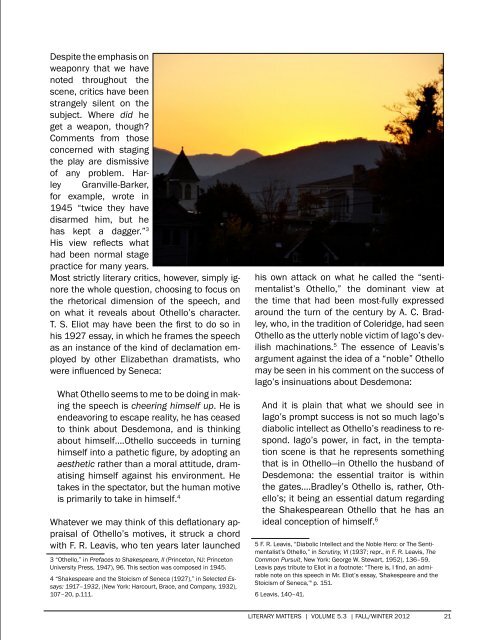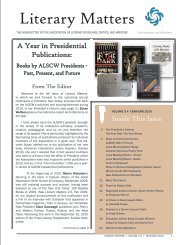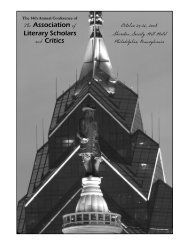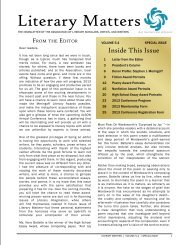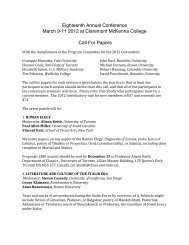I want to address a question that confrontsanyone who plans to stage Othello, but onethat critics tend to ignore: Where does Othelloget the weapon with which he kills himself?And I will suggest that the answer may well liein what critics have by no means ignored—hislast speech.Now although the critics seem disinterestedabout what weaponry Othello mayhave on his person as he is being ledaway, Shakespeare certainly does not, foron two prior occasions in the scene,he calls special attention to Othello’sweaponless state:first, when Montanodisarmshimafter hisattack onIago (“Iam notvaliantneither /But everypuny whipstergets my sword”[5.2.252–53] 1 );<strong>and</strong> again after he has re-armed himselfwith a sword secreted in the room <strong>and</strong> haswounded Iago with it (“Wrench his sword fromhim,” Lodovico comm<strong>and</strong>s [5.2.296]).Othello’s Lastm<strong>and</strong> is taken <strong>of</strong>f, / And Cassio rules in Cyprus”(5.2.339–41). But he will shortly discoverthat it is one thing to take <strong>of</strong>f Othello’scomm<strong>and</strong> <strong>and</strong> quite another to remove hispower, for when he tells him he “shall closeprisoner rest” (5.2.344) <strong>and</strong> gives the order,“Come, bring [him] away" (5.2.46), 2 Othellostops the general exodus by employing,for one last time, the “Othello magic,” thespell his spoken words evoke: “S<strong>of</strong>t you; aword or two before you go” (5.2.347). Thenin the eighteen lines that follow, hecharms his listeners with his words, ashe has done before when quellingthe incipient brawlthat Iago was stirringup amongBrabantio’sfollowerswith thesingle linethat manifeststhepower <strong>of</strong>his presence:“Keep up your brightswords, for the dewwill rust them” (1.2.60), <strong>and</strong> again in the“round unvarnish’d tale” that enchants hislisteners in the Duke’s council as it had enchantedDesdemona earlier (1.3.130–72).Speech: The Why <strong>of</strong> Itby John FreundThen, after a brief interlude, Lodovico turnsto Othello: “You must forsake this room<strong>and</strong> go with us. / Your power <strong>and</strong> your com-This article, with several additions <strong>and</strong> some minor alterations, is arevision <strong>of</strong> a paper delivered by the author in 2008 at the PennsylvaniaCollege English <strong>Association</strong> Conference in State College, PA.It never appeared in print, <strong>and</strong> was itself a considerable expansion<strong>of</strong> the section on Othello, “The Turk Within,” in Freund’s BrokenSymmetries: A Study <strong>of</strong> Agency in Shakespeare's Plays (New York:Peter Lang, 1991), 144–48. That treatment—as is the present one—was partially indebted to the late Pr<strong>of</strong>essor Edward Callan, a formercolleague from Western Michigan University. In the early 60s, headvanced the theory in a never-published paper that Othello’s lastspeech was—contrary to the opinions <strong>of</strong> Eliot <strong>and</strong> Leavis—for thepurpose <strong>of</strong> freeing himself from the grip <strong>of</strong> his guards, one arm at atime, as suggested by the text <strong>of</strong> the speech itself.1 This <strong>and</strong> all subsequent quotations from Othello are taken fromDavid Bevington ed., The Complete Works <strong>of</strong> Shakespeare, 3rded., (Glenview, IL: Scott, Foresman, <strong>and</strong> Company, 1980) unlessotherwise noted.Now, at the present juncture, his calm cadencesweave their spell once more beforethey culminate in the “bloody period” in whichtale <strong>and</strong> teller merge in a sudden crescendo<strong>of</strong> violence: “I took by the throat the circumciseddog, / And smote him, thus (stabs himself)”(5.2.364–65). Moments later, Cassioremarks, “This did I fear, but thought he hadno weapon” (5.2.369).Didn’t we all?2 This is the reading given by the First Quarto, one that has beenadopted by at least one modern edition—Hardin Craig <strong>and</strong> DavidBevington, eds., The Complete Works <strong>of</strong> Shakespeare, rev. ed.,(Glenview, IL: Scott, Foresman, <strong>and</strong> Company, 1973), 978—whichmakes explicit that it is Othello who is being compelled to leave.20 LITERARY MATTERS | VOLUME <strong>5.3</strong> | FaLL/WINTER 2012
Despite the emphasis onweaponry that we havenoted throughout thescene, critics have beenstrangely silent on thesubject. Where did heget a weapon, though?Comments from thoseconcerned with stagingthe play are dismissive<strong>of</strong> any problem. HarleyGranville-Barker,for example, wrote in1945 “twice they havedisarmed him, but hehas kept a dagger.” 3His view reflects whathad been normal stagepractice for many years.Most strictly literary critics, however, simply ignorethe whole question, choosing to focus onthe rhetorical dimension <strong>of</strong> the speech, <strong>and</strong>on what it reveals about Othello’s character.T. S. Eliot may have been the first to do so inhis 1927 essay, in which he frames the speechas an instance <strong>of</strong> the kind <strong>of</strong> declamation employedby other Elizabethan dramatists, whowere influenced by Seneca:What Othello seems to me to be doing in makingthe speech is cheering himself up. He isendeavoring to escape reality, he has ceasedto think about Desdemona, <strong>and</strong> is thinkingabout himself….Othello succeeds in turninghimself into a pathetic figure, by adopting anaesthetic rather than a moral attitude, dramatisinghimself against his environment. Hetakes in the spectator, but the human motiveis primarily to take in himself. 4Whatever we may think <strong>of</strong> this deflationary appraisal<strong>of</strong> Othello’s motives, it struck a chordwith F. R. Leavis, who ten years later launched3 “Othello,” in Prefaces to Shakespeare, II (Princeton, NJ: PrincetonUniversity Press, 1947), 96. This section was composed in 1945.4 “Shakespeare <strong>and</strong> the Stoicism <strong>of</strong> Seneca (1927),” in Selected Essays:1917–1932, (New York: Harcourt, Brace, <strong>and</strong> Company, 1932),107–20, p.111.his own attack on what he called the “sentimentalist’sOthello,” the dominant view atthe time that had been most-fully expressedaround the turn <strong>of</strong> the century by A. C. Bradley,who, in the tradition <strong>of</strong> Coleridge, had seenOthello as the utterly noble victim <strong>of</strong> Iago’s devilishmachinations. 5 The essence <strong>of</strong> Leavis’sargument against the idea <strong>of</strong> a “noble” Othellomay be seen in his comment on the success <strong>of</strong>Iago’s insinuations about Desdemona:And it is plain that what we should see inIago’s prompt success is not so much Iago’sdiabolic intellect as Othello’s readiness to respond.Iago’s power, in fact, in the temptationscene is that he represents somethingthat is in Othello—in Othello the husb<strong>and</strong> <strong>of</strong>Desdemona: the essential traitor is withinthe gates.…Bradley’s Othello is, rather, Othello’s;it being an essential datum regardingthe Shakespearean Othello that he has anideal conception <strong>of</strong> himself. 65 F. R. Leavis, “Diabolic Intellect <strong>and</strong> the Noble Hero: or The Sentimentalist’sOthello,” in Scrutiny, VI (1937; repr., in F. R. Leavis, TheCommon Pursuit, New York: George W. Stewart, 1952), 136–59.Leavis pays tribute to Eliot in a footnote: “There is, I find, an admirablenote on this speech in Mr. Eliot’s essay, 'Shakespeare <strong>and</strong> theStoicism <strong>of</strong> Seneca,'" p. 151.6 Leavis, 140–41.LITERARY MATTERS | VOLUME <strong>5.3</strong> | Fall/winter 2012 21


